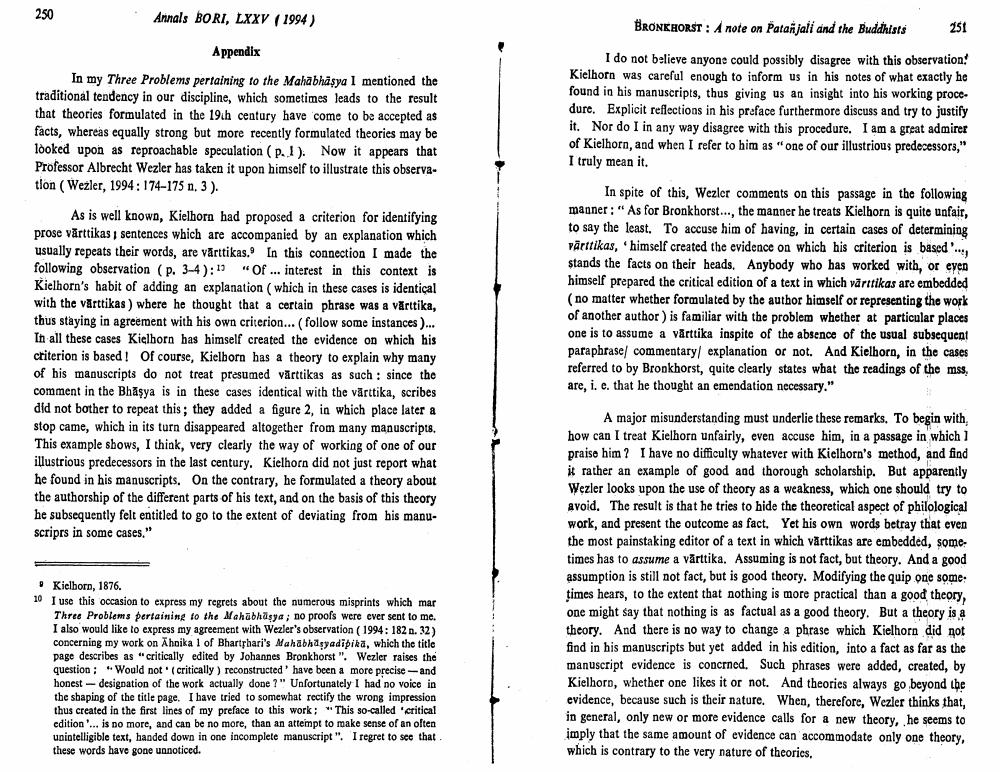Book Title: Note In Patanjali And The Buddhists Author(s): Johannes Bronkhorst Publisher: Johannes Bronkhorst View full book textPage 3
________________ Annals BORI, LXXV (1994) BRONKHORST : A note on Patanjali and the Buddhists 251 I do not believe anyone could possibly disagree with this observation! Kielhorn was careful enough to inform us in his notes of what exactly he found in his manuscripts, thus giving us an insight into his working proce dure. Explicit reflections in his preface furthermore discuss and try to justify it. Nor do I in any way disagree with this procedure. I am a great admirer of Kielhorn, and when I refer to him as one of our illustrious predecessors," I truly mean it. Appendix In my Three Problems pertaining to the Mahābhasya I mentioned the traditional tendency in our discipline, which sometimes leads to the result that theories formulated in the 19th century have come to be accepted as facts, whereas equally strong but more recently formulated theories may be looked upon as reproachable speculation (P.1). Now it appears that Professor Albrecht Wezler has taken it upon himself to illustrate this observatlon (Wezler, 1994: 174-175 n. 3). As is well known, Kielhorn had proposed a criterion for identifying prose vārttikas, sentences which are accompanied by an explanation which usually repeats their words, are vārttikas. In this connection I made the following observation (p. 3-4): "Of... interest in this context is Kielhorn's habit of adding an explanation (which in these cases is identical with the virttikas) wbere he thought that a certain phrase was a virttika, thus staying in agreement with his own criterion... (follow some instances )... In all these cases Kielborn has himself created the evidence on which his criterion is based! Of course, Kielborn has a theory to explain why many of his manuscripts do not treat presumed vårttikas as such: since the comment in the Bhasya is in these cases identical with the vārttika, scribes did not bother to repeat this, they added a figure 2, in which place later a stop came, which in its turn disappeared altogether from many manuscripts. This example shows, I think, very clearly the way of working of one of our illustrious predecessors in the last century. Kielhorn did not just report what he found in his manuscripts. On the contrary, he formulated a theory about the authorship of the different parts of his text, and on the basis of this theory he subsequently felt entitled to go to the extent of deviating from bis manuscriprs in some cases." In spite of this, Wezler comments on this passage in the following manner: "As for Bronkhorst..., the manner he treats Kielhorn is quite unfair, to say the least. To accuse him of having, in certain cases of determining värttikas, "himself created the evidence on which his criterion is based ..., stands the facts on their heads. Anybody who has worked with, or even himself prepared the critical edition of a text in which vårttikas are embedded (no matter whether formulated by the author himself or representing the work of another author ) is familiar with the problem whether at particular places one is to assume a vārttika inspite of the absence of the usual subsequent paraphrase commentary explanation or not. And Kielborn, in the cases referred to by Bronkhorst, quite clearly states what the readings of the mss, are, i.e. that he thought an emendation necessary." A major misunderstanding must underlie these remarks. To begin with, how can I treat Kielhorn unfairly, even accuse him, in a passage in which 1 praiso him? I have no difficulty whatever with Kielhoro's method, and find it rather an example of good and thorough scholarship. But apparently Wezler looks upon the use of theory as a weakness, which one should try to avoid. The result is that he tries to hide the theoretical aspect of philological work, and present the outcome as fact. Yet his own words betray that even the most painstaking editor of a text in which varttikas are embedded, some times has to assume a vārttika. Assuming is not fact, but theory. And a good assumption is still not fact, but is good theory. Modifying the quip one some times hears, to the extent that nothing is more practical than a good theory, one might say that nothing is as factual as a good theory. But a theory is a theory. And there is no way to change a phrase which Kielhora did not find in his manuscripts but yet added in his edition, into a fact as far as the manuscript evidence is concrned. Such phrases were added, created, by Kielhorn, whether one likes it or not. And theories always go beyond the evidence, because such is their nature. When, therefore, Wezler thinks that, in general, only new or more evidence calls for a new theory, he seems to imply that the same amount of evidence can accommodate only one theory, which is contrary to the very nature of theories, • Kielborn, 1876. 10 I use this occasion to express my regrets about the numerous misprints which mar Three Problems pertaining to the Mahābhasya; no proofs were ever sent to me. I also would like to express my agreement with Wezler's observation (1994: 182 n. 32) concerning my work on Khoika 1 of Bharthari's Mahabhasyadipika, which the title page describes as critically edited by Johannes Bronkhorst". Wezler raises the question; Would not critically reconstructed have been a more precise and honest-designation of the work actually done?" Unfortunately I had no voice in the sbaping of the title page. I have tried to somewhat rectify the wrong impression thus created in the first lines of my preface to this work: This so-called 'critical edition'... is no more, and can be no more, than an attempt to make sense of an often unistelligible text, handed down in one incomplete manuscript". I regret to see that these words have gone unnoticed.Page Navigation
1 2 3 4 5
